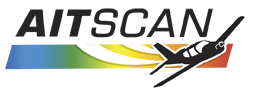

Thermal infrared (IR) imagery is imagery that shows heat. It is often in the form of a grayscale picture whose shades of gray indicate the differences in temperature and emissivity of objects in the image. Typically, objects in the image that look lighter are warmer and those that look darker are cooler. Bright white objects are the warmest in the images. Black objects are the coolest. Any object with a temperature above absolute zero ( 0 Kelvin or –273 degrees Celsius) emits infrared radiation. An infrared picture only shows objects which emit infrared wavelengths in the 3000-5000 nanometer range. Objects in visible light wavelengths of 400 to 700 nanometers are detected, but only because they also emit heat. An example of this would be a warm street light that can be seen in the IR imagery. We record infrared imagery on digital videotape and may later copy it to a VHS videotape and/or a JPEG digital image file. The image may be modified in a number of ways to enhance its value to the end user, such as creating a false-color image or adjusting the brightness and contrast of a grayscale image. The digital images are captured directly to JPEG format and placed on a CD-ROM.






Typical installations of infrared imaging and digital data systems. Click for larger images.
Areas of roof moisture contamination often manifest themselves as warmer (lighter colored) areas that may be nebulous in shape and sometimes mottled in appearance, although they are commonly found in linear or puddle-like shapes. The linear shapes many times follow low areas, drainage routes, roof edges and seams. Puddle-like round or oblong shapes often form around roof penetrations such as mechanical equipment, standpipes, vents and drains. The wet areas are lighter in color because the latent heat (from daylight sunshine) in the trapped water mass is greater than in the dry, functioning insulation or roof substrate. After sunset when the roof structure cools down, wet areas of roof insulation and other materials continue to radiate heat, allowing our sensitive infrared cameras to detect the sources of heat and record them for later analysis.


Performing infrared roof moisture surveys while standing on the roof is not the best method because imagery from a walk-on survey is not as useful as aerial imagery. The same laws of physics apply to both aerial IR and on-roof IR. A dry roof, low winds and no rain are needed on the night of the survey. However, the "window" when the roof is radiating heat differently from wet and dry areas is longer with aerial infrared because slight nuances of temperatures over large areas are recognizable. A high angle of view and high resolution are needed to produce usable imagery.


Example of entrained roof moisture in roofs.

Example of 4” GRE thermal image of a roof.


Example of visible image.
Example of thermal image.


IR Image
Visual Image


CAD Drawling
CAD Overlay

Photograph

Thermograph

CAD Drawing

Example of mosaic visible image of a low-sloped roof.

Example of mosaic thermal image of a low-sloped roof.

Example of CAD drawing of a low-sloped roof.

Example of mosaic visible image of a low-sloped roof with CAD drawing overlay.

Example of mosaic thermal image of a low-sloped roof with CAD drawing overlay.


